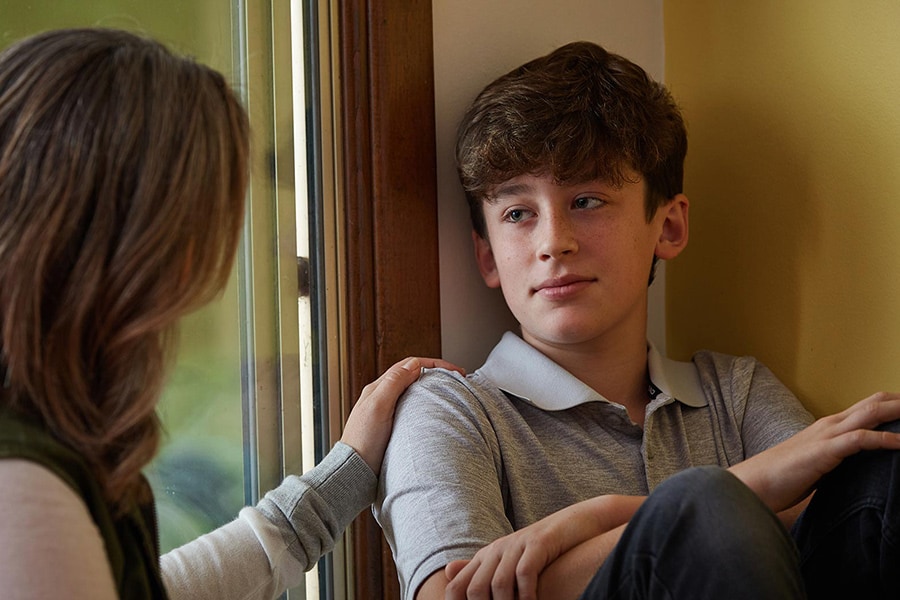Understanding Anxiety in Kids and Teens
Anxiety is a normal feeling of worry or nervousness we all experience at some point in our lives. The good news is kids can learn to identify and manage anxiety, and these skills can help them become more resilient (better able to handle life’s ups and downs).
Learn how to recognize signs of anxiety and what you can do to help your kids manage it.
In this article:

Understanding anxiety in kids
Just like adults, kids can feel anxiety about a number of different things, from common activities and experiences (e.g., public speaking) to social situations or specific fears (e.g., a fear of heights).
However, it’s important to recognize that sometimes anxiety can actually be helpful:
- When kids feel anxious about an upcoming test, game, or presentation, anxiety can help motivate them to study, practice, or prepare.
- When kids feel anxious about getting to school on time, they’re motivated to set an alarm and wake up at the same time each morning.
Anxiety can become problematic when it starts to get in the way of daily life. Sometimes when kids feel anxious, it can feel as though their thoughts are racing or that their brains are on high alert or in overdrive. This level of anxiety can lead kids to frequently worry about all the unknowns or worst-case scenarios, which can make it hard to stay calm, focus, or think clearly.

Common signs of anxiety
Whenever kids are having a hard time expressing how they feel with words, they typically show us through behavior. While anxiety can look different in every child, below are some common signs to watch for.
Physical signs of anxiety:
- Increased heart rate
- Shortness of breath
- Sweating
- Shakiness, feeling weak, or feeling dizzy
- Frequent headaches, stomachaches, or other physical pain with no known medical cause
Behavioral signs of anxiety:
- Frequent worrying
- Trouble concentrating (your child may seem distracted because they are consumed by worries and not able to think about anything else)
- Skipping activities your child used to enjoy
- Difficulty falling or staying asleep
- Clinginess to caregivers (i.e., not wanting to be alone)
- Extreme focus on and obsession with safety (e.g., asking a lot of questions, constantly seeking reassurance)
- Irritability or acting on edge

Watching for patterns in behavior
Sometimes, what appears to be defiant behavior (such as talking back) or procrastination can actually be anxiety. For example, if your child repeatedly avoids a certain task, it may be that they are anxious about failing or other potentially negative outcomes.
You know your child best, so watch for patterns in their behavior to determine whether or not there’s a deeper issue that needs to be addressed.

Talking to kids about anxiety
Anxiety can be uncomfortable and overwhelming, and it is natural to want to avoid difficult conversations. However, not talking about anxiety can make it worse. Here are some tips for starting the conversation:
Share your calm. Kids look to adults for cues on how to behave or react. While we know it’s difficult, try to remain calm when talking to your kids. When others around you are feeling anxious, it’s easy to start feeling anxious yourself—and the same goes for kids.
Start the conversation, and follow your child’s lead. You don’t have to wait for your child to come to you to talk about their feelings. Saying things like “I’m wondering how you are feeling” or “Tell me more about that” is a great way to let your child lead the conversation. Encourage and allow your child to speak freely about their feelings, and try to actively listen instead of interrupting or making assumptions.
Validate their feelings. Even if you don’t agree with your child or you think they’re being silly, their feelings are real to them. Let your child know you understand by repeating back exactly what you hear, without judging or interpreting. Let them know their feelings are OK and normal.
Avoid minimizing or dismissing feelings. It’s natural to want to make our kids feel better, but saying “Don’t worry about that” only teaches your child not to talk about how they feel.
Be honest yet reassuring. While you can’t promise that nothing will ever go wrong, you can let your child know that you are there for them and that you will get through tough times together.

Ways to prevent or reduce anxiety
Teach your child how to manage big feelings early on. It is difficult to learn new things when we are anxious, so it’s important to teach kids new skills when everyone is calm instead of waiting until a time when they actually need them. Once you’ve introduced healthy coping strategies, practice them regularly to make them a habit (just like brushing your teeth).
Maintain healthy routines. Following simple routines, such as going to bed and waking up at the same times each day, allows kids to know what to expect. Reducing uncertainty for kids helps them feel more in control, creating a sense of security and comfort. Practicing other healthy habits (such as eating balanced meals and snacks, getting enough sleep, and being active) are great ways to manage moods and lower anxiety. There may even be times when regularly practicing healthy habits can help prevent anxiety from occurring in the first place.
Create opportunities for choices. Sometimes anxiety comes from feeling out of control. Whenever possible, offer your child simple choices. For younger children, let them decide what they want to wear to school. For older children, let them pick the game or movie for family night.
Be a positive role model. Kids are constantly watching adults for cues. If your behavior is telling your child “you should be worried,” they will likely worry. You are human, and you have feelings too, but try to model how to manage anxiety in healthy ways.

Ways to help your child manage anxiety
Accept the unknown and focus on the here and now. Sometimes, anxiety can come from fear of future unknowns. Instead of constantly worrying about the unknown, help your child accept that they don’t know everything that will happen—and that it’s OK not to know. When your child is getting worked up about all the possible “what ifs,” help them pay attention to the present moment (the here and now) by taking deep breaths or practicing grounding.
Try to reframe thoughts. Is what your child thinking accurate and helpful? If not, help them reframe their thoughts by focusing on what is true and positive. Shifting their mindset can help them focus on reality rather than “what if.”
Teach your child to work through their anxiety rather than avoid it. It’s natural to want to avoid things that cause us to worry or be uncomfortable, but that only makes our anxiety worse. Instead of allowing your child to avoid talking about (or doing something) that causes anxiety, help them work through it. If your child fears public speaking and you allow them to stay home from school on the day of their presentation, you are actually teaching them to avoid challenges—which can increase their anxiety. What you can do instead is help your child prepare and practice relaxation strategies so that they can successfully work through the experience. Afterward, encourage your child to notice what it felt like to work through the challenge. Let your child know you’re proud of them for overcoming their fear or worry.
Try to gradually expose your child to things that cause them anxiety. If your child is terrified of dogs, putting them in a room with a big dog would likely backfire and cause more damage than good. Instead of introducing a dog right away, you may start by showing your child a picture of a dog, showing them a video of a dog, and then maybe taking them to a dog park and observing dogs from a safe distance. Taking these baby steps shows your child that they can get closer to the root of their fear and be OK. Then, when your child is ready, you can lead up to them actually petting a friendly dog. Be patient with your child, and go at their speed.
When to seek out support for anxiety
While some amount of anxiety is normal (and to be expected), it can be a problem when it starts to become excessive, negatively impacts daily life, or gets in the way of how your child functions. For example, is the anxiety getting in the way of your child’s ability to focus on or complete tasks, be social with peers, go to school, or engage in other activities that are normal for your child’s age (for an extended period of time)? If you’re concerned about your child’s anxiety, do not hesitate to reach out to your child’s pediatrician or a mental health professional.





